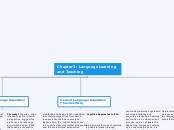Chapter 3: Language Learning and Teaching
Key Terms
Sociocultural perspective: Seeks to
understand human behavior and
personality development by examining
the rules of the social groups and
subgroups in which an individual is a
member.
Cognitive Approaches: modern approach to human
behaviour that focuses on how we think, with the
belief that such thought processes affect the way
in which we behave.
First Language Acquisition
Theories
Theory: Children learn their first
language through imitation and
positive reinforcement.
Chomsky: Children are able to
produce language and unique
utterances that go well beyond
what they could reasonably have
been exposed to and imitated.
Chomsky's theories, often
referred to as the innatist
perspective, suggest the
presence of a language
acquisition device (LAD)
that enables children to
figure out the underlying
rules of the language on
their own because of their
exposure to samples of
natural language.
Universal Grammer: Once
the LAD is activated and
children internalize the
rules for the structure (syntax)
of their language(s) they can
generate an infinite number of
unique, grammatically correct
utterances.
Second Language Acquisition
Theories (SLA)
Lightbown and Spada (2013) indetified
four major perspectives from which
theories about SLA have emerged:
Behaviorism, the innatist perspective,
the cognitive/developmental perspective
and the sociocultural perspective.
Atkinson (2011) makes a simpler
distinction between traditional
cognitivists approaches to SLA
and a range of alternatives to SLA
Cognitive Approaches to SLA
B.F Skinners theories of learning
as habit formation through
stimulus and response with
negative and positive
reinforcement greatly influenced
second language
5 interrelated hypotheses
Acquisition-learning hypothesis:
Learning a language vs.
acquiring a language. Learning
acquisition is a subconscious
process, we are not aware it is
happening. Language Learning
os a conscious process; it is
what we do in school.
Natural order hypothesis:
we acquire the parts of
the language in a
predictable order
Monitor hypothesis: we can
use learned language to monitor
or inspect what we acquire and
then correct errors
The input (comprehension) hypothesis:
we acquire language when we
understand messages or obtain
comprehensible input. Krishna argues
that we acquire language and develop
literacy by understanding messages
The affective filter hypothesis:
controls how much comprehensible
input gets through to the learner.
Why individual students make
different amounts of progress
when presented with the same input.
